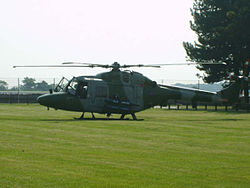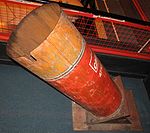- 1994 Crossmaglen mortar attack
-
1994 Crossmaglen mortar attack Part of The Troubles
A British Army Lynx helicopterLocation Crossmaglen, County Armagh, Northern Ireland Date 20 March 1994
20:27 (GMT)Target British Army base Attack type Mortar Injured 4 Perpetrator Provisional IRA The 1994 Crossmaglen mortar attack was an improvised mortar attack carried out by a Provisional Irish Republican Army (IRA) unit on 20 March 1994 against the British Army base at Crossmaglen, County Armagh, Northern Ireland. The single round lobbed at the compound shot down a Westland Lynx helicopter hovering over the helipad.
Contents
Background
Since the 1970s, the IRA developed a series of home-made mortars. The goal was to produce devices to be use as "stand-off" weapons, capable of being launched from safe ranges upon police or military outposts, and easy to conceal on dead-ground.[1] The different designs evolved in 1992 into the Mark 15 mortar, widely known as "Barrack buster". The mortar shell consisted of a one metre long metal propane cylinder with a diameter of 36 cm that contained around 70 kg of home-made explosives and with a range between 75 and 275 m. The cylinder was an adaptation of a commercial 'Kosangas' gas cylinder for heating and cooking gas used in rural areas in Ireland.[2] The first use of the "Barrack Buster" took place on 7 December 1992 against a security base in Ballygawley, County Tyrone.[3]
The attack
On the evening of 20 March 1994 a Lynx helicopter, serial nº ZD275, was in the process of landing at the large British army base at Crossmaglen. Meanwhile, an IRA unit had mounted a Mark 15 mortar on a tractor, concealed behind bales of hay. The tractor was parked 150 yards from the intended target, on waste ground. At 20:27, there was a sudden blackout across Crossmaglen's square and at the same time, a single mortar shell was lobbed into the barracks. The IRA had used the mains for the collapsing circuit of the firing pack, turning off the street's power supply. When the Lynx was hovering 100 feet over the helipad, the mortar round hit the aircraft on the tail's boom, which was severed from the fuselage. The machine span out of control, but the pilot was able to crash-land the Lynx inside the base. A Grenadier Guards' patrol spotted a huge orange ball from a mile away. Three members of the crew managed to get out with minor injuries, but a member of the RUC was trapped inside the blazing wreckage. The constable was rescued just before the fuel tanks and the ammunition started to explode. Author Toby Harnden described the incident as the most successful IRA operation against a helicopter in the course of the Troubles.[4][5][6]
Aftermath
After the incident, the IRA and Sinn Féin bore criticism from SDLP top politician Seamus Mallon, who said:
God knows how many people could have been killed. When you realise this mortar was lobbed over a number of houses it brings home the enormity of the danger so many people faced. Yet again you have Sinn Féin talking peace in the morning and carrying out these murderous attacks through the IRA in the evening.
John Fee, a local SDLP councillor which dubbed the attack as "an act of lunacy" was later beaten by two men outside his home. The IRA denied responsibility.[7] Corporal Wayne Cuckson of the Royal Logistic Corps was awarded the Queen's Gallantry Medal for dragging the wounded constable out of the crashed aircraft.[4]
There was a second mortar attack on a British military helicopter on 12 July 1994 at Newtownhamilton, when a RAF Puma crash-landed on a soccer pitch after being hit on its tail by another Mark 15 mortar launched from a tractor.[4]
The downing of two helicopters, along with the increasing sniper activity, was both a morale and military blow to the British forces in south County Armagh.[8]
See also
- Barrack buster
- 1985 Newry mortar attack
- Downing Street mortar attack
- Osnabrück mortar attack
- Provisional IRA South Armagh Brigade
- Chronology of Provisional Irish Republican Army actions (1990-1999)
Notes
References
- Geraghty, Tony (2000). The Irish War. Johns Hopkins University Press. ISBN 0002556170
- Harnden, Toby (2000). Bandit Country: The IRA and South Armagh. Hodder & Stoughton. ISBN 034071736X
- Ryder, Chris (2005). A Special Kind of Courage: 321 EOD Squadron - Battling the Bombers, Methuen. ISBN 0413772233
Coordinates: 54°4′33.5″N 6°36′32″W / 54.075972°N 6.60889°W
The Troubles History of Ireland · History of Northern Ireland · History of the United Kingdom · Irish nationalism · Irish republicanism · Irish unionism · Ulster loyalism Participants in the Troubles Chronology Political Parties Republican
paramilitariesSecurity forces of the United Kingdom
Loyalist
paramilitaries• Ulster Defence Association
• Ulster Volunteer Force
• Loyalist Volunteer Force
• Red Hand Commandos
• Young Citizen Volunteers
• Ulster Young Militants
• Ulster Resistance
• UVF Mid-Ulster Brigade
Linked to
• Some RUC and British Army members• Northern Ireland Civil Rights Association formed (1967)
• Battle of the Bogside (1969)
• Riots across Northern Ireland (1969)
• Beginning of Operation Banner (1969)
• Social Democratic and Labour Party formed (1970)
• Internment without trial begins with Operation Demetrius (1971)
• Bloody Sunday by British Army (1972)
• Northern Ireland government dissolved. Direct rule from London begins (1972)
• Bloody Friday by Provisional IRA (1972)
• Power sharing Northern Ireland Assembly set up with SDLP and Ulster Unionist Party in power (1973)
• Mountjoy Prison helicopter escape. Three Provisional IRA prisoners escape from Mountjoy Prison by helicopter (1973)
• Ulster Workers' Council strike causes power-sharing Northern Ireland Assembly to end (1974)
• Dublin and Monaghan bombings by UVF with alleged British Army assistance (1974)
• Kingsmill massacre by South Armagh Republican Action Force (1976)
• Warrenpoint Ambush by Provisional IRA (1979)
• 1981 Irish hunger strike by Provisional IRA and INLA members (1981)
• Hunger striker Bobby Sands elected MP. Marks turning point as Sinn Féin begins to move towards electoral politics (1981)
• Maze Prison escape. 38 Provisional IRA prisoners escape from H-Block 7 of HM Prison Maze (1983)
• Brighton hotel bombing by Provisional IRA (1984)
• Anglo-Irish Agreement between British and Irish governments (1985)
• Remembrance Day bombing by Provisional IRA (1987)
• Peace Process begins (1988)
• Operation Flavius, Milltown Cemetery attack and Corporals killings (1988)
• Bishopsgate bombing (1993)
• Downing Street Declaration (1993)
• First Provisional IRA ceasefire (1994)
• Loyalist ceasefire (1994)
• Docklands bombing (1996)
• 1996 Manchester bombing (1996)
• Second Provisional IRA ceasefire (1997)
• Good Friday Agreement (1998) signals the end of the Troubles
• Assembly elections held, with SDLP and UUP winning most seats (1998)
• Omagh bombing by dissident Real IRA (1998)• Unionist parties:
• Democratic Unionist Party
• Northern Ireland Unionist Party
• Ulster Unionist Party
• Progressive Unionist Party
• Conservative Party
• UK Unionist Party
• Traditional Unionist Voice
• Nationalist parties:
• Democratic Left
• Fianna Fáil
• Fine Gael
• Labour Party
• Progressive Democrats
• Sinn Féin
• Social Democratic & Labour Party
• Workers' Party of Ireland
• Irish Republican Socialist Party
• Republican Sinn Féin
• Cross-community parties:
• Alliance Party
• Historically important parties:
• Nationalist Party
• Northern Ireland Labour Party
• Protestant Unionist Party
• Vanguard Unionist Progressive Party
• Northern Ireland Women's Coalition
• People's Democracy
• Republican Labour Party
• Anti H-Block
• Irish Independence Party The Troubles at Wiktionary ·
The Troubles at Wiktionary ·  The Troubles at Wikibooks ·
The Troubles at Wikibooks ·  The Troubles at Wikiquote ·
The Troubles at Wikiquote ·  The Troubles at Wikisource ·
The Troubles at Wikisource ·  The Troubles at Commons ·
The Troubles at Commons ·  The Troubles at WikinewsCategories:
The Troubles at WikinewsCategories:- 1994 in Northern Ireland
- Provisional Irish Republican Army actions
- The Troubles in County Armagh
- Military history of County Armagh
- Conflicts in 1994
- Aircraft shootdowns
- Improvised explosive device bombings
- Army Air Corps
- 20th-century military history of the United Kingdom
- History of the British Army
- Battles and conflicts without fatalities
Wikimedia Foundation. 2010.


